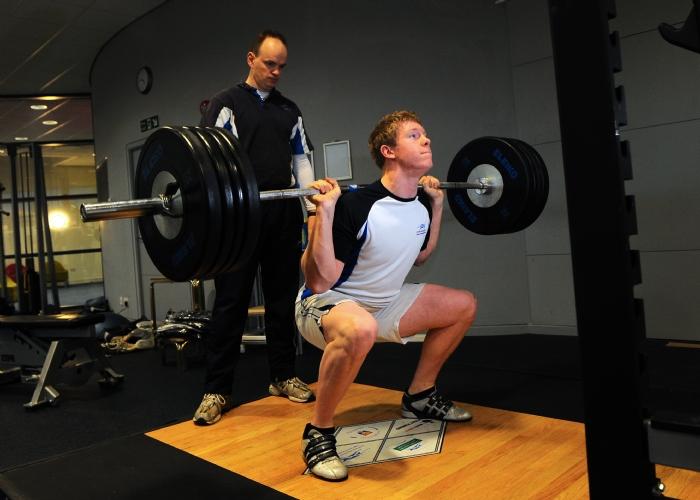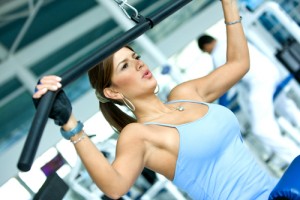Almost everyone is in search of more power on a bicycle. Power is velocity times force at the pedals. Velocity is how quickly the pedals turns over while force is the amount of energy put into each pedal stroke. Developing a fluid and fast pedal stroke happens almost exclusively on the bike, but developing more force can be done both on and off the bike with the proper strength training for cyclists.
Strength Training For Cyclists – Why Get Stronger Off the Bike?
There is a limit of how much force you can generate on the bike. With strength training you can go beyond that force by moving weight, be it body mass or weights, which will translate into greater on-the-bike force. It is important to keep similar body positions and ranges of motion to your riding position when strength training so your new-found strength will adapt well to the bike. You must make sure during even your heaviest lifting phases that you are also riding so you can put that strength to good use.
Strength training for cyclists is also important because cycling is a low impact exercises. Cyclists’ bone density is lower if they do not engage in some sort of load bearing activity off the bike to complement their on-the-bike training; strength training can fill that need. This is especially important for women.
Hit the Gym
When most people think of getting stronger, they think of going to a gym with free weights and machines. It is a great place to start strength training for cyclists. If it is a good gym, all of the equipment that you could want is there. There are also people that can help you with proper form and progression in a gym training plan, but be aware that the needs of a cyclist are different than most people who are at a gym.
Free Weights versus Machines
There are a lot of options at the gym of what to lift. If you have the option, always choose the free weight option for a given exercise. On the bike, you are not guided by a machine and must stabilize your movement on your own. A weight machine takes away from the development of some of those stabilizing muscles that would otherwise benefit you while riding.
Additionally, choose exercises that use more than one joint. There are very few activities in life that require movement from one joint. You want your weight room experience to simulate life as much as possible.
Periodization
Just like a cycling training plan should be periodized, so should strength training for cyclists. The base periods should mirror the on-the-bike training; building good form towards increasingly high volume while working up to moderate intensities. The build periods will bring down the volume a bit but will also increase intensity. Think higher weights, towards maximal efforts. Remember to include rest weeks too otherwise the strength training will be for naught.
As big events approach, it is important to dial back lifting and focus on maintenance. It is like the recovery ride of strength training.
Keeping Perspective
The goal of strength training for cyclists is build strength to use on the bike. It is not to build mass or look great at the beach. It is especially important to remember if you are training in a setting with other people. It does not matter what they are doing or what they think about your regimen; stick to the plan and focus on your goals.
Body Weight Exercises
No access to the gym or there is not enough time in the day to get there? Body weight exercises are easy to do at home and you can get most of the benefits of a gym. You may not be able to push tremendous weight as you could at the gym at the end of the build period but you can get in a lot of repetitions quickly and cheaply. Important exercises are lunges and squats, especially one-legged squats, which really build up your stabilizing muscles.
On the Bike
For very specific strength training, you can do it on the bike. The motion is exactly what you need and you are already out riding. Again, you are limited by how much force you can produce, but you will be able to build more strength than you had before. These workouts involve putting the bike into a gear that lets you ride at 60 rpm or less. While you are doing it, it should feel like you are pushing incredibly hard. Again, not as hard as lifting weights, but far harder than your average ride. You will be able to get in a lot of repetitions very quickly. One thing to note on this is that you should ease into it week by week as it can put a lot of stress on your knees which can injure them if they’re not ready.
Masters
As people age, their ability to maintain strength decreases. It is especially important for masters to engage in some sort of strength training for cyclists to maximize their ability on the bike. It will provide a dramatic competitive edge over their counterparts that do not strength train and also stave off some of the negative results of aging.
Women
Female cyclists will benefit a great degree more than male cyclists from strength training because of the bone density issues cyclists face. Women are more likely to develop osteoporosis than men and a strength training will help fight off its onset.
Core
A popular current trend is core strengthening. It is very time efficient, can be done every day, and is very important to stabilize your body during riding, especially sprinting. Keeping a steady and calm upper body allows your legs to do all the work more efficiently. Core work is easy to do at home with little or no equipment.
A core muscle is anything that originates or inserts in the spine or pelvis. It covers a lot of muscles, but the important ones for cyclists are between the hips and armpits.
Try It Out
If you are looking for another way to boost your power, strength training for cyclists is it. You will be able to turn over a gear higher at a given cadence after dedicating to a program for a bit. Who doesn’t want that? Also, strength training for cyclists further develops tendons and supporting muscles which can help to avoid overuse injuries as they are strong enough to handle the stress in which you put them under.


